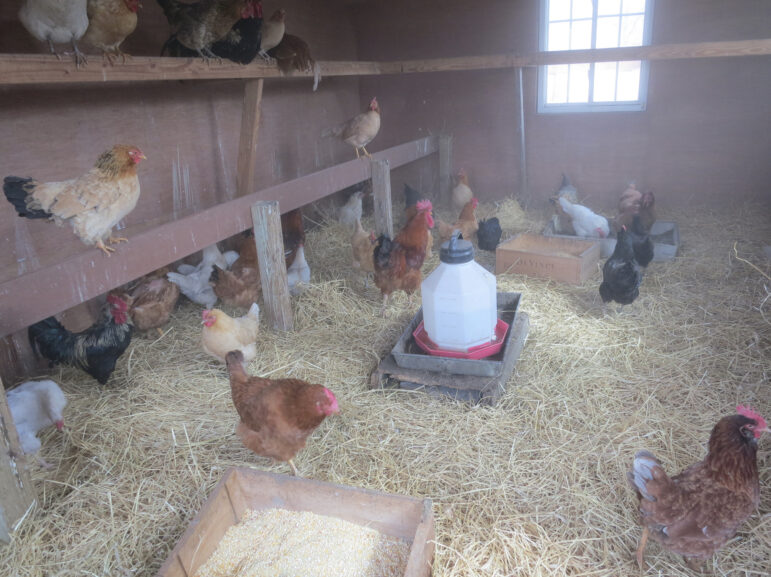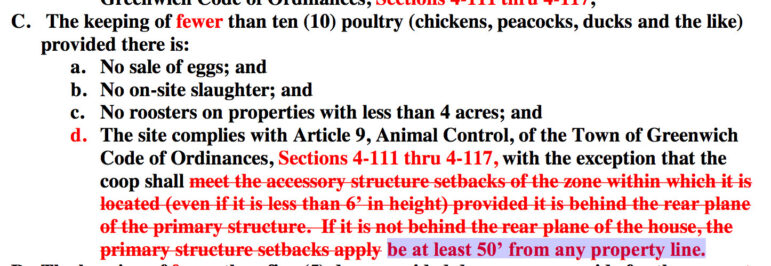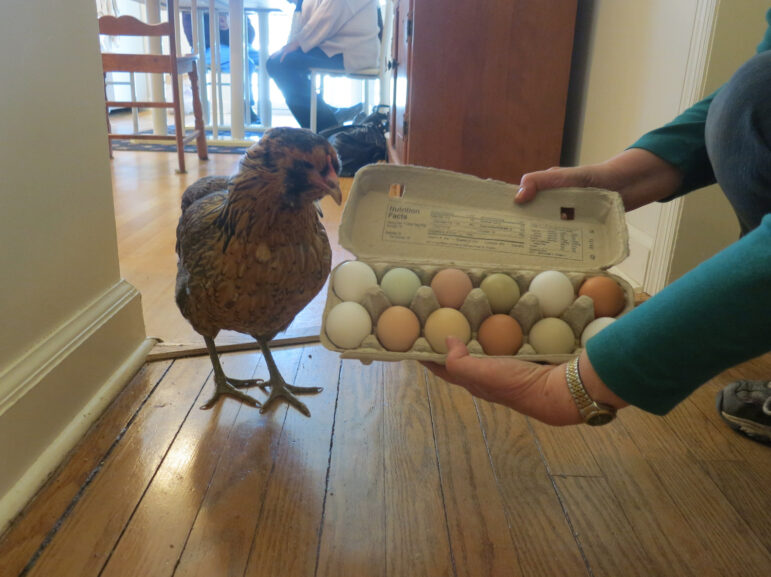The Dec 20 P&Z meeting was the last one for director Katie DeLuca, who is retiring at the end of the month, and it was a long one, starting at 4:00pm and ending around 11:30pm.
One of the last items on the agenda concerned keeping domestic animals. Talk focused on chicken coops and a proposed 50 ft setback requirement.
Ironically, the subject was taken up by P&Z because of complaints about roosters.
An existing town ordinance only refers to 10 or more chickens.

At P&Z, testimony was passionate. Twenty-four people were still on Zoom six hours into the meeting when the text amendment was addressed. Six people testified in favor of chicken keeping. Though only one man, Kevin Dillon, testified in favor of the 50 ft setback, the commission said they’d received input from a number of others who also supported the text amendment.
P&Z surveyed other towns and found that New Canaan required chicken coops be 300 ft from the property line.
“You’re going to have opinions on both sides, and you’ve got chicken lovers and they’ve never seen a rat in their lives. And they’re the cleanest animals in the world,” commissioner Peter Lowe said. “You’ve got appeal to the greater good and not be imposing on neighbors.”
The commission noted that rats and cleanliness were not zoning issues, but rather health issues.
They encouraged the people who opposed the text amendment to go to the RTM and seek to have the existing ordinance changed to enhance how chickens are kept, and make it unlikely coops would attract rats.
They said that if people championing chickens had success at the RTM, the commission would remove the 50 foot restriction.

PUBLIC COMMENT
Patricia Adams, a former naturalist at the New Canaan Nature Center, said the proposed text amendment was overly restrictive, perpetuated socioeconomic discrimination and penalized people who are food insecure.
She said the 50 foot requirement created an onerous condition for residents who live on lots under a half acre and that health hazards of chicken keeping had been exaggerated in the local news.
“This suggested language of locating the chicken coop 50 ft from any property line is inherently discriminatory.”
She argued that people living on smaller lots were more in need of their own food sources, especially considering inflation.
“It is inherently violating their personal liberties to produce their own food and it takes a toll on people who would otherwise have to use food stamps or forego the health and nutritional benefits of eggs,” she said.
Adams pointed out that Greenwich had a history as a farming community.
“Requiring the 50 ft setback means that only affluent families who can afford to purchase a large property lot in Greenwich are eligible to participate in a reliable, lower carbon footprint lifestyle and food security, which discriminates against less affluent residents,” Adams said. “This restriction limits chicken keeping to the hobby of the affluent.”
“Residents should have a choice and a right to access food sources that have been treated humanely, the way chickens would be if they were raised in a backyard flock by a chicken keeper who treats their hens like pets,” she added.
P&Z chair Margarita Alban the commission had done extensive research before proposing the 50 foot setback.
“The people asking for this specifically are on small lots… Just so you know, it isn’t rich people who wanted to get rid of it,” Alban said.
And, Alban continued, “the counter-argument we heard is that given our proximity to New York, we are not a rural farming community.”
Mr. Lowe said while he was sympathetic to those who did not live on large lots, “There may be more people who are inconvenienced by the presence of chickens on small lots.”

Kevin Dillon from Cos Cob, who previously testified that his property has a rat infestation as the result of his neighbor’s chicken coop on the property line, described the text amendment as an important “first step.”
Mr. Dillon said the CDC tracked illnesses, including those from backyard poultry coops.
“They run the gamut, but mostly salmonella. They also transfer from pets to humans,” Dillon said. “The diseases of the feces and the nuisance of the noise and dropping of the property value…”
He said a portion of his property was no longer usable and that the roof of his neighbor’s coop was covered in feces.
“It’s disgusting. Nobody would want to be 300 feet from this structure. You can imagine what 10 feet from my bedroom is like. Not being able to open the window…”
Dillon said he empathized with Ms Adams’ love and compassion for chickens. But, he said his quality of life had taken a toll.
Ali Ghiorsi, a local food systems advocate, said, “In the context of the climate change, the global pandemic, and international conflict, we should be considering everyone’s food security, not just those of lower income.”
“We are really looking at this from a perspective of abundance, from a perspective of privilege. Our food system is in very much peril,” Ghiorse added. “We are blessed this evening to be having the luxury of this conversation. That’s exactly what it is: luxury and privilege.”
Tim Hanna described the sound of chickens as peaceful and welcoming, and said in addition to providing eggs, chickens eat ticks. He said when a chicken coop becomes a blight, it should be dealt with through education.
“The gentleman raising the issue – he’s got a history of law suits and conspiracy theories, so he’ll keep coming up with all kinds of things. That’s what he does,” Mr. Hanna said.
Mr. Hanna went on to defend roosters. “Roosters are necessary. That’s how we get more chickens. Roosters also protect chickens. They maintain the order with the hens, and maintain a healthy flock. The young and old roosters rarely crow. We don’t have issues at night – the hens and roosters all go to roost at dusk.”
He also objected to the part of the text amendment prohibiting sale of eggs, on-site slaughter and roosters on properties with less than 4 acres.
Claudia Shia Macora said her son had benefited educationally from her family’s chicken keeping, and had even written about it in his college essay.
She agreed that the new rule eliminated anyone with a small property from keeping chickens, and defended the practice.
“We have a Ring camera on our coop. We have power. We brought water back there. Our chickens are part of our family,” she said.
“My neighbor’s dog barks all the time. There are noises in neighborhoods. I understand not wanting a rooster, but a 50 ft setback from a property line. It’s so restrictive.”
Her son Luke said it was unfair to change the rule based on one person’s situation.
The Macoras said their chicken food was contained in the coop, and when the chickens are in the yard they eat ticks.
“One person is ruining it for everyone,” Ms Macora said, adding that with the 50 ft setback no one in Cos Cob could have a chicken coop.
“Rats are a completely different thing,” Alban said. “This is a very dense neighborhood we’re in.”
Ms Alban said P&Z had received complaints from many more than from Mr. Dillon.
Myra Klockenbrink also testified against the 50 foot setback.
“It would be egregious for you to effectively prohibit the keeping of chickens by Greenwich residents because of a sanitation issue that should be handled as an issue of sanitation, not as one of keeping chickens,” she said.
Carl Marinaccio from Glenville said he’d been keeping chickens for years, and also runs a farm in upstate New York.
“If you have the chicken coop set up right with a bottom, a run, and proper fencing, you don’t have a problem of rats… My chickens can get out and be free range when I want them to be,” he said. “And if you have a rooster, they can be a hindrance when they cock-a-doodle-doo, but the real issue is sanitation. If this neighbor would only build a coop right, I feel these neighbors can probably get along.”
After public comment the commissioners weighed in.
“You cannot leave any food out at night. Anybody who doesn’t have rats says the same thing,” Ms Alban said. “My problem is it isn’t the coop. The rats can burrow and will chew through a wall.”
There’s nothing we can do about that, we don’t do health,” she continued, adding that since the last meeting she had consulted the town attorney, the Greenwich Health Dept, the town administrator and the First Selectman.
“The bottom line is nothing has been done and we have to protect the health and safety of residents, and rats are a safety and health issue,” Alban said.
“We are protecting, as best we can, with the limited tools we have, the health and safety of neighbors, and people’s enjoyment of their property rights,” said commissioner Bob Barolak.
“We cannot pass a law that says people must pick up food in their chicken coops. The RTM can do that and pass an ordinance that says if you don’t pick up your chicken feed up every night you can’t keep your chickens,” Barolak said.
Ms Alban agreed. “P&Z promises to keep our end of the bargain, Myra (Klockenbrink), if you can get the Sustainability Committee to put something before the RTM that writes a health ordinance so that the chickens are carefully maintained and there’s no hazard to life and safety from having chickens, then we’ll get rid of the distance (requirement).”
“This is an enforcement issue,” Mr. Lowe said, adding that the town was inadequate in terms of personnel in terms of enforcement.
Mr. Barolak said the problem was that there was no ordinance for the Health Dept to enforce.
“If you are a neighbor with nine chickens, you are, as you say, ‘a chicken out of luck,'” Barolak said.
Commissioner Dennis Yeskey said, “I think this is a major health hazard.”
“We’re not a farming community. Let’s be real here. We have a Health issue we’re trying to address at P&Z,” Yeskey.
“The Health Dept has not enforced it, so here’s our chance to make an impact,” Yeskey said. “It will stop people from doing what was done to this particular guy.”
The commission voted unanimously in favor of the text amendment.
See also:
P&Z Watch: “Chicken Coops and Rats. They Go Together Like Peanut Butter and Jelly.” Dec 7, 2022